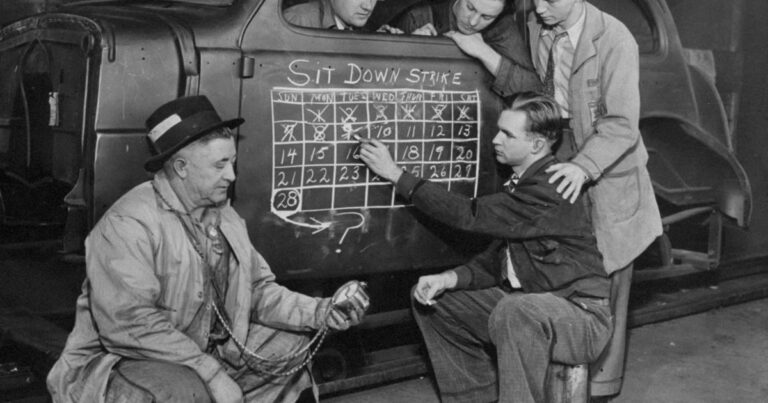NEW YORK (CNN) — During the final days of 1936, about 50 General Motors auto workers shut down machinery and sat at the Fisher Body Plant No. 2 in Flint, Michigan.
The workers, members of the small United Auto Workers union founded just a year earlier, wanted to improve harsh working conditions at the mighty General Motors Co., the world’s largest manufacturing company. They also demanded that GM recognize the union as the workers’ bargaining agent in negotiations.
The UAW’s sit-down strike across GM plants lasted 44 days. It was the most significant work stoppage of the 20th century and is considered a turning point in American business-worker relations. This was a milestone for labor unions, sparking a wave of worker organizing across the country.
The UAW is currently on strike for the first time against Detroit’s Big Three: General Motors, Ford, and Stellantis. The strike comes at a critical time for both the labor movement, which has been reinvigorated with the dawn of the electric vehicle era, and the auto industry, which is in transition.
The UAW, led by upstart president Sean Fein, has updated its tactics. The UAW called its new strategy “stand-up strikes,” after the sit-down strikes that began 87 years ago, and began strikes targeting select factories.
“Sean Fein draws from the union’s long history and modernizes the UAW’s traditions,” said Thomas Sugrue, a historian at New York University. “Unions rely on understandings of the past, but they need to be reinvented to respond to the current situation.”
Birth of the UAW
In the 1930s, UAW workers endured the breakneck speed they were forced to work on assembly lines, the arbitrary power GM foremen had to hire and fire them, and the hardships they endured in life. They were protesting against low wages. GM had thwarted efforts by workers to form a union, including through espionage and firing organizers.
At the time, sit-in strikes were widespread in Europe, and UAW workers were inspired by their efforts.
Sit-in strikes were a novel tactic and had several advantages over traditional strikes, where workers walk off the job, writes labor journalist Stephen Greenhouse in “Battered and Hardened: The Past of American Labor.” , present, future”.
Police frequently attacked workers, and replacement workers could easily be taken out of work while picketing outside. Sitting kept workers in the factory and close to their stations, and “scabbing” did not occur. Management was reluctant to call the police for fear of damaging valuable machinery.
The initial strike at Fisher Body Plant No. 2 quickly spread to other GM plants in various cities, wreaking havoc on GM’s operations.
On January 11, 1937, two weeks after the strike began, factory workers faced off against GM security guards and Flint police as the company cut off heat and electricity and prevented food deliveries to workers inside the factory. There was a collision. Dozens of people were injured in the clashes. Michigan Governor Frank Murphy called in the National Guard and ordered both sides to negotiate.
Forty-four days later, the two sides reached an agreement in which GM would recognize the UAW as a bargaining agent for workers who wanted to unionize.
It was a landmark victory for the union.
One union leader told the New York Times, “Workers in other basic, high-volume industries have gained confidence from the autoworkers’ struggle that they too can win similar rights in their own industries.” I will be confident of that,” he said.
GM’s sit-in strike led to a surge in UAW membership.
Membership rose from 88,000 in February 1937 to 400,000 in October. According to Greenhouse, by 1941 membership had grown to 649,000.
The sit-in strikes also sparked a wave of unionization and strikes in other industries.
In 1937, Time magazine said, “Sitting has replaced baseball as America’s pastime.”
stand up strike
UAW victories led to unionization at Chrysler in 1939 and Ford in 1941.
Detroit’s unionized wage increases and company-provided benefits became the norm for other manufacturing jobs and led to the creation of the mid-20th century middle class.
“Auto industry jobs have been an important foundation for the rise of the middle class throughout American history,” said Joseph McCartin, a labor historian at Georgetown University.
But in recent years, non-union domestic and international competition has weakened the U.S. auto industry and eroded UAW jobs and benefits.
Unions across the United States have also declined, peaking at 33.4% of employees in 1945. Last year, 10.1% of workers joined a union.
The current UAW leadership, led by Chairman Fein, is trying to regain energy from the sit-down strikes against GM in the 1930s.
The UAW called the strike at the three plants a “stand up strike” and called it a strategic “new approach” to quit their jobs.
“The stand-up strike is our generation’s response to the movement that built our union, the 1937 sit-in strikes,” the UAW said in a statement. “Then and now, our industry is changing rapidly and workers are being left behind.”
McCartin said negotiations between the UAW and Detroit’s Big Three will have a long-term impact on both the auto industry and manufacturing jobs.
“The question here is, as manufacturing jobs grow, will they function as middle-class jobs?”
